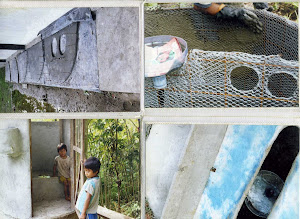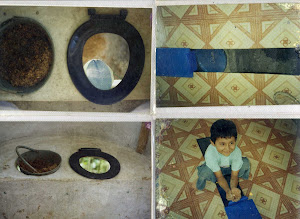(English text below)
Es muy sencillo:
- un piso de ferrocemento con cerámicas, con un hueco de 18 x 35 cm y un hueco de 2 cm (a un ángulo de unos 45 grados) donde poner ...
- un embudo corriente de plástico (de 18 cm diámetro),
- una manguera perforada para distribuir la orina en el suelo entre las plantas (12 m),
- un barril de plástico para captar las heces y el material seco (trabado en su lugar con un arreglo de tablas),
- postes de cemento, y
- techo, paredes y gradas al gusto de los usuarios.
- las heces se quedan encapsuladas frente a las inundaciones,
- no se contamina el estero donde pescan y se bañan,
- los nutrientes son reciclados,
- no hace falta estar pendiente del calendario para saber cuando sacar las heces descompuestas y tampoco tener donde almacenarlas.
A Dry Toilet for Areas of High Flooding
We built these 10 Urine-diverting Dry Toilets (UDDTs) in a fishing village called Puerto El Salvador, within the Churute Mangroves Ecological Reserve (Naranjal County, Guayas Province), in a project organized by the Peace Corps Volunteer John Wilson. It is impressive that, despite being so close to the ocean, they suffer flooding of up to 140 cm of fresh water, and it can be above their ankles for months. The plan had been to build the same model as I had done in Añangu, Cuya Loma and Omaere, but with flooding so high, there were going to be big problems. So I had the idea to build more the way the inhabitants often build their own houses, above the flooding and in a dismantleable way, be moved and re-built according to movements of the estuary.
It is very simple:
- a ferrocement floor covered with ceramic tiles, with a big hole 18 x 35 cm and a little hole of 2 cm (at a 45 degree angle) where one puts ...
- a standard plastic funnel (18 cm diameter),
- a perforated hose to disperse the urine on the soil among the plants (12 m),
- a plastic barrel to collect the feces and dry cover material (wedged from underneath against the floor, using 3 planks nailed together in the form of a table),
- cement posts, and
- roof, walls, door, and steps as the users prefer to build them.
- the feces are encapsulated against future flooding,
- the estuary where they fish and swim is not contaminated,
- the nutrients are recycled,
- there is no need to be watching the calendar to know when the feces have decomposed and are safe and they do not need to have a place to store them.








